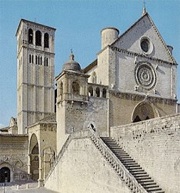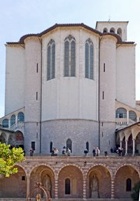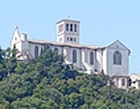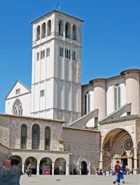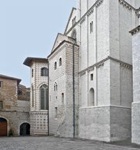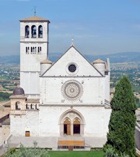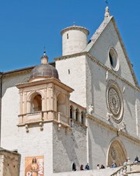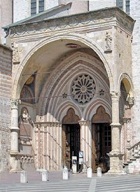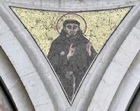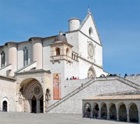Architecture
The basilica consists of two independent churches, each of which has a single nave and transept. They are oriented with their apses (i.e. liturgical east) facing west and the facade of the upper church facing east, towards Assisi. The churches and the adjacent convent were built on a hill outside Assisi, but were gradually incorporated into the city as the depression that originally separated them was filled in over the centuries. The stairs from the upper piazza to the door to the lower church were built in 1474 on the orders of Pope Sixtus IV.
Construction began in the apse, which was built as a single, two-storey structure, albeit that:
-
✴the apse of the lower church has a semi-circular plan; while
-
✴the apse of the upper church is polygonal.
The lower church was designed ab initio with sufficient strength to support the upper church, and the circular staircase turrets to the sides of the apse were designed to link the two structures. The transepts of the two churches also have identical floor plans.
The initial design seems to have also involved a nave of three bays for each church, with a single storey narthex in front of the west-facing facade of the lower church. This basic structure was probably complete by the time that the relics of St Francis were interred in the rock below the altar of the high altar of the lower church in 1230.
This initial design seems to have been modified soon after:
-
✴the narthex was incorporated as a second transept of the lower church, and the entrance to this part of the building was moved to its south side (see below); and
-
✴a fourth bay was added to the nave of the upper church, so that the new east wall of the narthex formed the foundations of its facade.
The original buttresses were built:
-
✴at the junctions between the naves and the transepts; and
-
✴to the sides of the facade of the upper church.
Semicircular buttresses that echo the design of the staircase turrets were later added along the sides of the naves.
The campanile of the left nave was clearly a later addition to the original structure. It seems to have been complete by 1239, when its first bells were cast. It originally terminated in a tall, pointed upper storey, but this had to be demolished in the 16th century.
The sacristies of the Upper and Lower Churches were subsequently built, one above the other, between the left transept and the campanile. The
lower sacristy was presumably the “
sagrestia nuova” near the entrance to the convent that was documented in 1341. It communicates with the “secret” treasury at the base of the campanile. The external entrances to these two spaces are some way above ground level, and must have been accessed by a removable ladder.
Facade of the Upper Church (ca. 1239)
The simple brick facade of the upper church is divided into two horizontal zones, with a simple gable above. The double portal, like that of the lower church, was designed to allow the circulation of pilgrims. The rose window in the middle register is surrounded by the symbols of the Evangelists.
The ground in front of the facade was donated in 1246 and terraced to form what is now the upper piazza in 1278.
The open loggia on the left of the facade was first documented in 1589 as the place from which the
Sacro Velo della Madonna (sacred veil of the Virgin) was displayed for veneration on the second day of Pentecost. (Its attribution to
Valentino Martelli in 1607, while ubiquitous, is incorrect).
Entrance to the Lower Church
The double portal was probably built after 1271, when a lady called Berta left five poplars from her farm for doors to be made in memory of St Francis. (This was part of a programme of modifications that improved the flow of pilgrims visiting the Lower Church, as described in the page on the
lower church).
-
✴The rose window above and between the portals is of the style of the Cosmati workshop.
-
✴The mosaic (
ca. 1320) of St Francis in the triangle between the doors and under the rose window is attributed to
Giovanni di Bonino.
The inscription along the arch of the porch in front of the entrance records that the Minister General Francesco Nani built it in 1487. A payment for the design had been made in the previous year to Francesco di Bartolomeo da Pietrasanta. This elegant porch is supported by two columns, and decorated with reliefs of the figures of the Annunciation below a frieze of festoons.
A legacy (1543) by Brother Ottaviano Preconi was used to finance replacement doors:
-
✴the doors (1564) on the left, which were designed by Dono Doni and carved by Nicolò di Ugolino, depict scenes from the lives of SS Francis and Clare; and
-
✴the doors (1573) on the right are by Pompeo Scurscione and depict scenes from the lives of SS Antony of Padua and Louis of Toulouse.
The land used for what is now the lower piazza was donated in 1246. The portico around this piazza was built in 1474 and the two flights of steps that connect it to the upper piazza were added in 1731.


